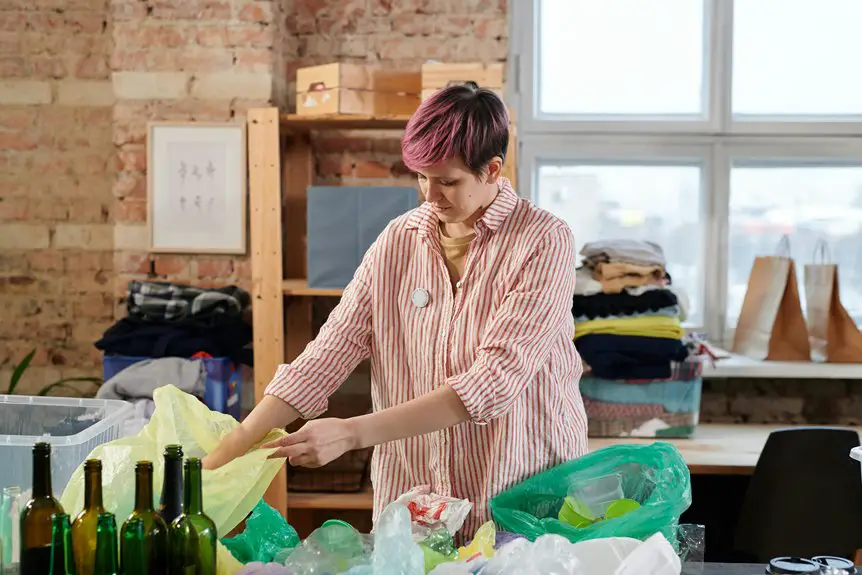When you wear clothes made from recycled plastic bottles, you might not realize they could contain harmful toxins. For instance, many brands use phthalates in their production processes, which can leach into the fabric. This raises concerns about skin irritation and hormonal disruption over time. So, what does this mean for your wardrobe and overall health? Exploring the details can help you make more informed choices about sustainable fashion.
Table of Contents
Key Takeaways
- Clothes made from recycled plastic bottles can release toxins during manufacturing and processing due to harmful substances introduced in the recycling process.
- Phthalates and other chemicals in synthetic fabrics may leach into the environment and skin, leading to hormonal disruption and health concerns.
- Inconsistent testing for toxin levels in recycled clothing results in varying safety standards that may expose consumers to harmful substances.
- Regulatory gaps and a lack of transparency in manufacturing processes can mislead consumers about potential toxins in recycled plastic clothing.
- Choosing brands that prioritize transparency and safety can minimize exposure to toxins and reduce environmental impacts associated with recycled fabric production.
Understanding Microfiber Pollution
As you wash synthetic clothes made from recycled plastic bottles, tiny fibers—known as microfibers—shed into the water.
These microscopic strands can escape into wastewater systems, often making their way into rivers and oceans. Once there, they contribute considerably to water pollution, harming aquatic life.
Fish and other marine animals can ingest these microfibers, mistaking them for food, which disrupts their digestive systems and can affect their health. Additionally, microfibers can attract and absorb harmful pollutants from the surrounding water.
By choosing to wash your synthetic clothes less frequently or using microfiber-catching laundry bags, you can help minimize this pollution.
Being mindful of your laundry habits can considerably impact the environment and contribute to cleaner waterways.
The Role of Phthalates and Other Chemicals
While many people appreciate the benefits of wearing clothes made from recycled plastic bottles, it’s vital to comprehend the role of phthalates and other chemicals in these garments.
Phthalates, often used to soften plastics, can leach into the environment and potentially into your skin. These chemicals are linked to hormonal disruption and other health concerns.
Additionally, the processing of recycled plastics may introduce other harmful substances during manufacturing. It’s essential to evaluate the source and quality of the materials used.
By choosing brands that prioritize safety and transparency, you can minimize your exposure to these harmful chemicals.
Health Impacts of Synthetic Fibers
Although synthetic fibers, such as those made from recycled plastic bottles, offer innovative solutions for sustainable fashion, they can also pose health risks. You might not realize that wearing these fabrics can expose you to harmful substances. For instance, some synthetic materials may release microplastics and chemicals during washing and wear. Here’s a quick overview of potential health impacts:
| Health Impact | Description | Prevention Tips |
|---|---|---|
| Skin Irritation | Can cause rashes or allergic reactions | Opt for natural fibers |
| Respiratory Issues | Inhalation of microplastics possible | Wash clothes before wearing |
| Endocrine Disruption | Chemicals may disrupt hormonal balance | Choose certified products |
| Long-term Exposure | Potential links to chronic conditions | Limit synthetic fiber use |
Stay informed about what you’re wearing!
Environmental Consequences of Microfiber Release
When you wash synthetic garments made from recycled plastic bottles, tiny microfibers often break loose and enter waterways, causing significant environmental damage.
These microfibers, which are too small to be filtered out by wastewater treatment plants, contribute to the pollution of oceans and rivers. Marine life mistakes them for food, leading to ingestion by fish and other aquatic creatures. This not only threatens their health but also affects the entire food chain, including humans who consume contaminated seafood.
Additionally, microplastics can accumulate toxic chemicals, further worsening their impact on ecosystems.
The Manufacturing Process and Its Hazards
As the demand for clothes made from recycled plastic bottles grows, understanding the manufacturing process and its associated hazards becomes essential.
You should know that turning plastic bottles into fabric involves several steps, including sorting, cleaning, shredding, and melting the plastic. During this process, harmful chemicals can be released, particularly if the bottles contain residues of toxic substances.
You might also encounter risks related to worker safety, as handling hot materials and operating machinery can lead to injuries.
Additionally, the energy-intensive nature of the process can contribute to greenhouse gas emissions. By being aware of these hazards, you can make more informed choices about the clothing you purchase and its impact on both the environment and human health.
Challenges in the Circular Economy
The journey of recycling plastic bottles into clothing doesn’t end with the manufacturing process; it also faces significant challenges within the circular economy.
You might encounter issues like limited consumer awareness and acceptance, which can hinder demand for recycled products. Many people still prefer traditional materials, viewing them as more reliable.
Additionally, the quality of recycled fibers can vary, affecting the performance and durability of the clothing.
The performance and durability of clothing can be impacted by the varying quality of recycled fibers.
Supply chain complexities also arise, making it difficult to consistently source enough recycled materials.
Moreover, the infrastructure for recycling varies by region, leading to inconsistent availability.
To truly succeed in the circular economy, you’ll need to address these challenges and promote a culture that values sustainable fashion choices.
Importance of Regulatory Oversight
When it comes to clothing made from recycled plastic bottles, regulatory oversight is essential.
You’ll want to reflect on how current regulatory gaps can impact sustainability efforts and the necessity of certification standards for eco-friendly materials.
Ensuring industry accountability measures helps maintain trust and drives positive change in the market.
Current Regulatory Gaps
While many brands tout the benefits of clothes made from recycled plastic bottles, significant regulatory gaps leave consumers and the environment vulnerable.
Without strict oversight, you may unknowingly expose yourself to potential toxins released during production. Here are a few concerns you should consider:
- Lack of Transparency: Many manufacturers don’t disclose the processes used to transform plastics into fabric.
- Inconsistent Testing: There’s no standardized testing to measure toxin levels in these garments, meaning safety can vary widely.
- Limited Accountability: Brands often escape responsibility for environmental impacts, leaving consumers in the dark about their choices.
As a result, it’s essential to stay informed and advocate for stronger regulations to protect both your health and the planet.
Certification Standards Necessity
Without clear certification standards, you can’t be confident that the clothes made from recycled plastic bottles are as safe and eco-friendly as they claim to be.
These standards help consumers like you understand what’s really in the clothes you wear. You deserve transparency regarding chemicals or toxins that might leach from these garments.
Regulatory oversight guarantees that manufacturers meet specific safety and environmental criteria, giving you peace of mind. When brands adhere to recognized certifications, you can trust that their products are tested and verified.
This not only protects your health but also promotes sustainable practices in the industry. By supporting certified products, you’re encouraging businesses to prioritize safety and environmental responsibility, fostering a healthier planet for everyone.
Industry Accountability Measures
Clear certification standards pave the way for effective industry accountability measures, which are essential for guaranteeing the integrity of clothing made from recycled plastic bottles.
Without proper oversight, there’s a risk of harmful chemicals slipping into products you wear. Implementing robust regulations helps protect consumers and the environment.
Consider the following key elements of accountability:
- Transparency: Brands should openly disclose their manufacturing processes and materials.
- Testing: Regular testing for toxins in fabrics guarantees safety and compliance with standards.
- Sustainability Practices: Companies must adopt eco-friendly practices throughout their supply chain.
Consumer Awareness and Education
As consumers become more aware of environmental issues, understanding the impact of clothing made from recycled plastic bottles is essential.
As environmental awareness grows, it’s crucial to comprehend the effects of clothing produced from recycled plastic bottles.
You might wonder about the processes involved in turning waste into wearable items and whether these products release any toxins. It’s vital to educate yourself on how these clothes are made and the potential health implications.
Look for brands that prioritize transparency about their materials and manufacturing practices. By seeking out certifications or eco-labels, you can make informed choices.
Don’t hesitate to ask questions and engage with companies about their sustainability practices. Your awareness and choices can drive demand for safer, environmentally friendly clothing, influencing the industry toward better practices that benefit both you and the planet.
Innovations in Sustainable Materials
As you explore the world of sustainable fashion, you’ll discover exciting advancements in biodegradable fabric alternatives and innovative dyeing techniques.
These breakthroughs not only reduce environmental impact but also offer new ways to create vibrant, eco-friendly clothing.
Let’s take a closer look at how these materials are changing the industry for the better.
Biodegradable Fabric Alternatives
While synthetic fabrics dominate the fashion industry, a growing movement towards biodegradable fabric alternatives is reshaping our approach to sustainable materials.
These innovative textiles break down naturally, reducing environmental impact. You’ll find several exciting options emerging in the market:
- Organic Cotton: Grown without synthetic pesticides, it’s a natural choice that decomposes easily.
- Tencel: Made from sustainably sourced wood pulp, it’s soft, breathable, and fully biodegradable.
- Hemp: This durable plant requires minimal resources and can return nutrients to the soil when it decomposes.
Innovations in Dyeing Techniques
The push for sustainability in fashion isn’t just about the materials; it extends to how we color our fabrics, too. Innovative dyeing techniques are emerging that minimize environmental impact while still delivering vibrant colors. You can find methods like waterless dyeing, which greatly reduces water usage, and plant-based dyes, which eliminate harmful chemicals.
Here’s a quick look at some innovative techniques:
| Technique | Benefits |
|---|---|
| Waterless Dyeing | Reduces water consumption |
| Plant-Based Dyes | Non-toxic and biodegradable |
| Digital Printing | Less waste and energy efficient |
| Low-Temperature Dyeing | Saves energy during production |
With these advancements, you can enjoy stylish, eco-friendly clothing that doesn’t compromise on quality or aesthetics.
Future Directions for Safer Clothing Practices
To guarantee a sustainable future in fashion, we must prioritize safer clothing practices that reduce environmental impact.
You’ll want to reflect on the following approaches:
- Sustainable Materials: Shift towards organic, biodegradable fabrics that minimize harm to ecosystems.
- Eco-Friendly Production: Support brands using low-impact manufacturing processes that conserve water and energy.
- Recycling and Upcycling: Embrace brands that promote circular fashion, turning old garments into new ones to reduce waste.
Frequently Asked Questions
Can Recycled Plastic Clothing Be Safely Washed Without Shedding Microfibers?
Did you know that about 700,000 microfibers can shed from a single wash? While you can wash recycled plastic clothing, using a microfiber filter can help reduce shedding and protect our oceans from pollution.
What Brands Prioritize Safety in Recycled Plastic Clothing Production?
When you’re looking for brands that prioritize safety in recycled plastic clothing, check out Patagonia, Adidas, and Repreve. They focus on sustainable practices and often test their products to guarantee they meet safety standards.
How Can Consumers Reduce Their Exposure to Toxins in Clothing?
While fashion dazzles, toxins lurk. You can reduce exposure by choosing organic materials, washing new clothes before wearing, and supporting brands that prioritize sustainable, chemical-free practices. Your choices can lead to a healthier wardrobe.
Are There Specific Certifications to Look for in Recycled Plastic Clothing?
When shopping for recycled plastic clothing, look for certifications like Global Recycled Standard or OEKO-TEX. These labels guarantee the materials meet environmental and safety standards, giving you peace of mind about your purchases.
What Alternatives Exist to Recycled Plastic Clothing for Sustainability?
You can explore organic cotton, hemp, Tencel, and bamboo as sustainable clothing alternatives. These materials reduce environmental impact and promote eco-friendly practices, helping you make responsible fashion choices without relying on recycled plastic.
- Does Calico Fabric Shrink? Your Guide to Prevention and Care - June 19, 2025
- How to Properly Wash, Prewash, and Care for Calico Fabric - June 19, 2025
- What Is Calico Fabric? A Complete Guide for Beginners - June 19, 2025





